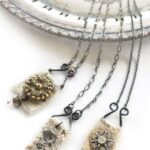Are you interested in learning how to price beaded jewelry and set your handmade creations for success in the market? Pricing can be a challenging aspect for jewelry makers, but with the right strategies and understanding of various factors, it can become much easier.
In this article, we will guide you through the process of pricing your beaded jewelry effectively, from understanding the costs involved to determining the value of your time and labor. By following these steps, you can ensure that your prices are competitive, profitable, and appealing to potential customers.
When it comes to pricing beaded jewelry, there are several factors to consider. Firstly, understanding the cost of materials and supplies is crucial in setting a reasonable price for your pieces. Additionally, determining the value of your time and labor is essential for ensuring that you are appropriately compensated for your effort.
Researching the market and competitor pricing will also help you position your products effectively. Plus, calculating overhead and business costs will give you a clear picture of what it takes to run your jewelry business.
In this article, we will delve into practical pricing strategies for different types of beaded jewelry and discuss the importance of perceived value and branding in setting prices. We will also provide tips for adjusting prices and dealing with pricing pressure to help you navigate challenges in the marketplace. By the end of this guide, you will have all the tools you need to confidently set your beaded jewelry prices for success.
Understanding the Cost of Materials and Supplies
When it comes to pricing beaded jewelry, one of the most important factors to consider is the cost of materials and supplies. This includes the beads themselves, as well as any additional components such as clasps, wires, and threads. Understanding how to accurately calculate these costs is crucial in determining the overall price of your jewelry.
To calculate the cost of materials for each piece of jewelry, you will need to keep track of the quantity and cost of each type of bead or component used. Many suppliers sell beads in bulk, so it’s important to divide the total cost by the number of units to get an accurate per-unit cost. Additionally, don’t forget to include any shipping or handling fees associated with acquiring your materials.
Once you have a clear understanding of the cost of materials and supplies for each piece of beaded jewelry, you can use this information as a baseline for setting your prices. Keep in mind that different types of beads may have varying costs, so it’s essential to be meticulous in tracking expenses for each individual piece. By doing so, you can ensure that your pricing accurately reflects the investment you’ve made in crafting your jewelry.
| Cost Item | Cost Amount |
|---|---|
| Beads | $100 |
| Clasps | $20 |
| Wires/Threads | $15 |
| Shipping/Handling | $10 |
By understanding the true cost of your materials and supplies, you can make informed decisions on how to price your beaded jewelry. This ensures that your prices are competitive while still allowing you to cover your expenses and make a profit.
It also provides transparency regarding the value of your work and allows customers to see why certain pieces may be priced higher than others based on their composition. Taking these factors into account is essential for successfully pricing and selling beaded jewelry in today’s market.
Determining the Value of Your Time and Labor
When it comes to pricing beaded jewelry, one of the most important factors to consider is the value of your time and labor. This goes beyond simply factoring in the cost of materials and supplies. As a jewelry maker, you must also place a value on your creative work and the time you spend crafting each piece. Here are some key considerations for determining the value of your time and labor when pricing your beaded jewelry:
- Calculate the hours spent: It’s important to keep track of the amount of time you devote to creating each piece of jewelry. This includes not only the actual beading process, but also any design planning, assembly, and finishing touches.
- Determine an hourly rate: Once you have a clear understanding of how much time goes into making each piece, you can establish an hourly rate for your labor. Consider factors such as skill level, expertise, and the quality of your work when setting this rate.
- Consider market standards: Researching what other jewelry makers charge for their time and labor can provide valuable insight into industry norms. While it’s essential to value your own skills and craftsmanship, it’s also important to remain competitive within the market.
By considering these factors, you can ensure that you are accurately reflecting the true value of your time and labor in the prices you set for your beaded jewelry. Balancing these costs with other elements such as material expenses and business overhead will ultimately help you establish fair and profitable pricing for your creations.
Researching the Market and Competitor Pricing
When it comes to pricing beaded jewelry, one of the key factors to consider is the market and competitor pricing. Understanding what similar products are selling for in the market will help you set competitive prices for your own creations. Here are some steps on how to research the market and competitor pricing effectively:
- Start by researching online platforms such as Etsy, Amazon, and other e-commerce websites where handmade jewelry is sold. Take note of the prices of similar beaded jewelry items and analyze the materials used, design complexity, and overall quality.
- Visit local craft fairs, artisan markets, and jewelry stores to see firsthand what kind of beaded jewelry is being offered and at what price points. Engage with both customers and fellow artisans to gather insights on pricing strategies that work in your area.
- Utilize social media platforms to join groups or communities focused on handmade jewelry. This can provide valuable information on current trends, customer preferences, and pricing standards within the industry.
By conducting thorough research on market trends and competitor pricing, you can gain valuable insights that will help you make informed decisions when setting the prices for your beaded jewelry pieces.
Remember that while it’s important to stay competitive in terms of pricing, it’s equally crucial to value your time and craftsmanship. Finding a balance between these factors will ultimately contribute to the success of your business.
Calculating Overhead and Business Costs
Understanding Overhead Costs
When pricing beaded jewelry, it’s essential to consider all the overhead costs associated with running your business. Overhead costs include expenses such as rent, utilities, insurance, marketing, and packaging materials. These costs are not directly tied to the production of a specific piece of jewelry but are necessary for the overall operation of your business. To accurately calculate your overhead costs, make a list of all your monthly and annual expenses related to the business.
Allocating Overhead Costs
Once you have a clear understanding of your overhead costs, you will need to allocate these costs to each piece of beaded jewelry. One way to do this is by determining how much of your total monthly or annual expenses can be attributed to each individual piece of jewelry.
You can calculate this by dividing your total overhead costs by the number of pieces you anticipate selling within a specific time frame. This will give you an idea of how much overhead cost needs to be factored into the pricing of each item.
Setting Profit Margin
In addition to covering the cost of materials and labor, setting prices for beaded jewelry should also account for a profit margin that contributes towards ongoing business operations and growth. Your profit margin should also support future investments in new materials and tools, as well as allow for any unforeseen expenses that may arise in the course of doing business.
Understanding overhead costs and incorporating a suitable profit margin into your pricing strategy is crucial for sustaining your business in the long run.
Pricing Strategies for Different Types of Beaded Jewelry
When it comes to pricing beaded jewelry, it’s important to consider the different types of jewelry you are offering. Some pieces may require more time and materials to create, while others may have a higher perceived value. Here are some pricing strategies for different types of beaded jewelry:
1. Simple Designs: For basic beaded bracelets or earrings with minimal embellishments, a straightforward pricing approach may be appropriate. Consider calculating the cost of materials and supplies, then adding a markup for your time and labor.
2. Intricate Designs: If you specialize in creating intricate beaded necklaces or statement pieces with elaborate beadwork, you may need to adjust your pricing strategy. These pieces often require more time and attention to detail, so it’s essential to factor in the complexity of the design when determining the price.
3. Custom Orders: When pricing custom-made beaded jewelry, it’s crucial to communicate with the customer about their specific requirements. Consider charging a premium for personalized designs, as they often involve additional time for consulting with the client and finding the right materials.
It’s also essential to research market trends and competitor pricing when establishing prices for different types of beaded jewelry. Understanding what similar items are selling for can help you position your products effectively in the marketplace.
| Types of Beaded Jewelry | Pricing Strategy |
|---|---|
| Simple Designs | Straightforward pricing based on materials and labor |
| Intricate Designs | Adjust pricing based on complexity and time-consuming nature |
| Custom Orders | Charge a premium for personalized designs based on consultation time and special materials |
By implementing these strategies, you can ensure that your beaded jewelry is priced effectively according to its unique characteristics and market demand.
The Importance of Perceived Value and Branding
When it comes to pricing beaded jewelry, one crucial factor to consider is the perceived value of your creations. Perceived value refers to how consumers perceive the worth of your jewelry based on various factors such as quality, uniqueness, and brand reputation. Understanding and effectively manipulating this perception can greatly impact the success of your pricing strategy.
Factors Affecting Perceived Value
Several elements can influence the perceived value of your beaded jewelry. The quality of materials and craftsmanship, the intricacy of the design, and the uniqueness of the piece all play a significant role in shaping how customers view your jewelry. Additionally, branding and marketing efforts contribute to how your brand is perceived in the market, which ultimately affects how much customers are willing to pay for your products.
Building a Strong Brand
Building a strong brand identity is essential for creating a positive perception and commanding higher prices for your beaded jewelry. Consistency in design aesthetic, use of high-quality materials, and excellent customer service all contribute to building a strong brand that customers trust. This trust leads to an increased perceived value of your products, allowing you to price them accordingly.
In summary, understanding how perceived value impacts pricing for beaded jewelry is crucial for success in the industry. By focusing on factors that positively influence this perception and building a strong brand identity, you can effectively set prices that reflect the true worth of your creations and attract more discerning customers who are willing to pay a premium for quality and uniqueness.
Tips for Adjusting Prices and Dealing With Pricing Pressure
When it comes to pricing beaded jewelry, it’s important to remember that the market is constantly changing, and therefore so should your prices. In this section, we will discuss some tips for adjusting prices and dealing with pricing pressure in the beaded jewelry business.
One tip for adjusting prices is to regularly review your costs and make any necessary adjustments. This means keeping track of the cost of materials and supplies, as well as the value of your time and labor. As these costs fluctuate, so should your prices. It’s also important to stay aware of changes in the market and competitor pricing, as this can also impact how you should price your beaded jewelry.
Dealing with pricing pressure is another important aspect of running a successful beaded jewelry business. When facing pressure to lower your prices, it’s crucial to stand firm in the value of your product. This may mean educating customers on the value of handmade, artisanal jewelry and the quality of materials used. Additionally, offering special promotions or discounts strategically can help alleviate pricing pressure without compromising the perceived value of your jewelry.
By following these tips for adjusting prices and dealing with pricing pressure, you can ensure that your beaded jewelry business remains competitive while maintaining the value of your products. Understanding how to price beaded jewelry is an ongoing process that requires flexibility and confidence in the worth of your creations.
Conclusion
Setting the right prices for your beaded jewelry is crucial to the success of your business. After understanding the costs of materials and supplies, determining the value of your time and labor, researching the market, and calculating overhead and business costs, you are now equipped with the knowledge to set your prices effectively. By following these steps, you can ensure that your pricing not only covers your expenses but also provides a fair profit for your hard work.
It is important to remember that pricing beaded jewelry is not just about covering costs; it’s also about perceived value and branding. Customers are willing to pay more for high-quality, unique pieces with a compelling story behind them. By creating a strong brand and emphasizing the value of your handmade jewelry, you can justify higher prices and attract customers who appreciate craftsmanship.
As you navigate through the process of setting prices for your beaded jewelry, it’s essential to be flexible and willing to adjust as needed. Keep an eye on market trends and competitor pricing while staying true to the value of your unique creations. Pricing pressure may arise from various sources, but by staying confident in the worth of your work and maintaining transparency with customers about your pricing rationale, you can successfully navigate these challenges.
In conclusion, understanding how to price beaded jewelry is a multi-faceted task that involves careful consideration of costs, market dynamics, perceived value, branding, and flexibility. By incorporating these elements into your pricing strategy, you can set your beaded jewelry prices for success.
Frequently Asked Questions
Is Selling Beaded Jewelry Profitable?
Selling beaded jewelry can indeed be profitable, especially if you have a unique and high-quality product. Factors such as design, materials used, and target market can all impact the profitability of selling beaded jewelry.
How Do You Market Beaded Jewelry?
There are several ways to market beaded jewelry effectively. Utilizing social media platforms like Instagram and Facebook can help reach a wider audience. Additionally, participating in craft fairs, pop-up shops, or partnering with local boutiques can also boost sales.
Do Beaded Bracelets Sell Well?
Beaded bracelets can sell quite well, especially when they are on-trend and cater to popular styles. Additionally, offering customizable options or creating themed collections for different occasions can increase their desirability and sales potential.

Welcome to my jewelry blog! My name is Sarah and I am the owner of this blog.
I love making jewelry and sharing my creations with others.
So whether you’re someone who loves wearing jewelry yourself or simply enjoys learning about it, be sure to check out my blog for insightful posts on everything related to this exciting topic!





